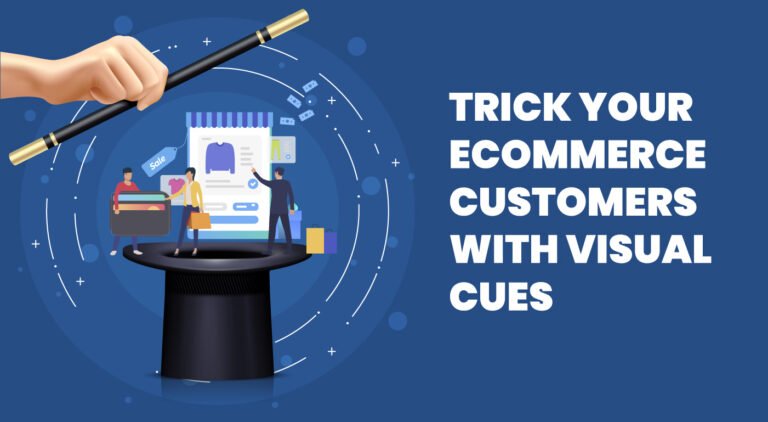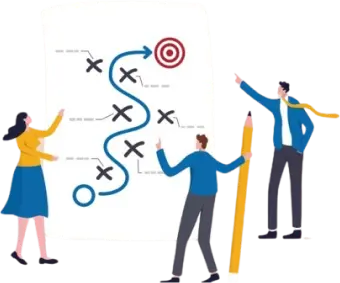18 May, 2022 | ecommerce development services
Trick Your Ecommerce Customers With Visual Cues

Well, the saying is pretty easy than actually doing it.
Don't worry; we will help you with some astonishing ideas that you can deploy at your ecommerce store. This can have a significant impact on the CRO of your business. When it comes to ecommerce, "the look of the product" is the sellable property. So, here we will be talking about all how you can transform your website to its visually appealing counterpart. You must be following all the ecommerce standards, creating engaging product detail pages and marketing with the campaigns to bring in conversion. But, above all you have to bring in quality traffic and more crucial is to make them stay in your store.Visual cues can make it happen, let us discuss more of them.
What are the visual cues?
The elements on the web page, which are capable of directing the visitor's attention visually to the action you want them to take are referred to as visual cues. Visual cues are often referred to as directional cues. These cues can be directed to CTA, contact forms, product page or category page.What is the need for visual cues?
As we have already mentioned, for an ecommerce business, looks matters! We, humans, are visually oriented. Naturally, visual hierarchy plays a vital role in the nature of scanning the content. Visual cues play with the scanning psychology of our brains and draw the attention of visitors towards the CTAs. The parallax websites are created with the same notion in mind. When a user gets some interactive element on the site, they can't do anything but at least play around with it through it's least possible to add a parallax theme for your ecommerce store, as they are heavy. You can always try the CSS tricks basic animations to make elements of your site engaging.Here's the list of visual cues that you can try for your ecommerce store:
Suggestive and explicit visual cues
Based on the type of approach, visual cues can be explicit and suggestive. The explicit cues like arrows, lines directly indicate towards the end goal. It's a direct approach, and there is no guesswork involved. Explicit visuals are easier to understand. Thus, they often gain more attention than suggestive ones. On the contrary note, suggestive visual cues need understanding about their utility. They are surely capable of delivering much deeper messages. The explicit approach can be good for conversion, and suggestiveness can do much better at sharing the emotion or adding a message of your brand. Taskworld has used the suggestive idea to deliver the message of connecting remote workers as a team.Take colour contrast
Ecommerce businesses play with colours more than often. Don't you put that white background to give a clear look of all the products and a dark background for light coloured products? Of course, you do that! The primary reason behind is contrast colours amplify the look of the product. With an understanding of colour philosophy, it is really easy to trigger customer action. During web page design, you can add a contrast colour section for your banners and category pages. Like, Amazon uses dark blue on the header section, light colour for banners, and varying colour schemes for category pages. One shoe doesn't fit all the sizes. Likewise, Amazon has different product imaging requirements for different product categories. Before working on the product detail pages, you can refer to its imaging guidelines. It can be a lot helpful in walking with the standards and improving the quality of the product detail pages.Frame your content
The frame or boundary of the content is also capable of drawing the user's attention. Let's consider, you have all the product categories listed on the homepage of your store, but you want to bring the focus of your customers on the product category that you have recently launched. Here are a few ideas that you can try:- Play with the colour philosophy: Set the background colour for all of your existing categories white, and give some dark background for the newly launched category. Out of curiosity, visitors will be driven towards your new category.
- Add the frame: You can add a thick frame near your new category. The encapsulation will change the approach of the visitor towards the displayed content.
- Make it interactive: In addition to all the above things, you can tweak the CSS and add animation. The change can be as small as the arrival of the frame on hovering, or change of background colour, display of carousel images of the products of that category or anything else.
Count on the negative space
Your website is like the canvas, but, that doesn't mean that you have to paint it fully. You have to leave the borders as well as the white or light space that can make it easier for others to understand your picturization. Empty space of your site, which is not occupied with the content or any media element, is referred to as the negative space of the website. This space of the website is dedicated to separate the clutter and draw the attention of the user towards the action-oriented sections. Wherever you add CTAs remember to make the nearby sections as spacious as possible. Recently, minimalism is making its edge in the market. The reason behind inclination towards the plainer and simpler design is, delivering your message turns easier with less clutter.How can I know the performance of visual cues?
These are the handful of visual cues that you may like to test on your store. Some of them will outperform the other. You can make the list of ideas that can be fruitful for your business niche. The visual data representation tools like heatmaps can help you gain an understanding of the type of visual cues that are helping you grab the user's attention. You can try A/B testing and get the best ideas that are performing well. If you want to add all the functionalities of your choice to your store, you must look for custom website design services for professional help. Learning and implementing takes time, and you can't risk your online business with your trials. Your single mistake in implementation can open the doors for hackers to add some phishing links and take a toll on your data. So, we recommend you do not leave any loophole. Provided that you already own an ecommerce store and are looking for web designers, you can write to us at sales@www.wedowebapps.co.uk.Frequently Asked Questions
One way to use A/B testing is to have two versions of the website, one with the visual cues and one without, and randomly show each version to a group of website visitors. By tracking metrics such as conversion rates, click-through rates, and time spent on the website, you can determine which version of the website is more effective at engaging customers and encouraging them to make a purchase. It's important to have a large enough sample size and to track the metrics for a significant amount of time to ensure accurate results. There are also numerous tools and software available for conducting A/B testing on ecommerce websites.
There are a number of ways visual cues can encourage customers to make a purchase on an ecommerce website. One way is to use a countdown timer or limited time offer graphic that emphasizes the urgency of buying the product before the sale ends. You can also use bright, attention-grabbing colors, bold fonts, and compelling images to draw the customer's eye towards the product and encourage them to take action. Another effective method is to include customer reviews and testimonials that showcase the value and quality of the product, providing social proof that can help customers feel confident in their purchase decision. Overall, the key is to create a sense of urgency while visually highlighting the benefits and value of the product.
The placement and design of visual cues can greatly impact customer behavior on an ecommerce website. For example, placing prominent call-to-action buttons, such as "Add to Cart" or "Buy Now," in a prominent and easy-to-find location can encourage customers to make a purchase. Similarly, using high-quality product images and videos, prominently displaying customer reviews and ratings, and offering personalized recommendations can all help to increase customer engagement and conversions on an ecommerce site. Additionally, using visual cues like countdown timers or limited stock notices can create a sense of urgency and encourage customers to act quickly, increasing the likelihood of a purchase.
Visual cues in ecommerce refer to the use of images, videos, colors, and other design elements to guide customers towards making a purchase. For example, high-quality product images and videos can help customers better understand the product and increase their confidence in making a purchase. Clear and contrasting color schemes can also help draw attention to important elements such as call-to-action buttons. Additionally, social proof elements such as customer reviews and ratings can also influence customer behavior by providing a sense of trust and reliability. By utilizing visual cues effectively, online retailers can improve their customer experience and ultimately lead to increased sales and customer loyalty.
When it comes to using images and videos to showcase products and enhance user experience, there are a few best practices to keep in mind. Firstly, make sure that the images and videos are of high quality and showcase the product in the best possible light. Secondly, consider using different angles and perspectives to give users a better understanding of the product. Thirdly, make sure that the images and videos are optimized for web and mobile use, so that they load quickly and don't slow down the user experience. Lastly, consider incorporating interactive elements such as zoom or 360-degree views to give users a more immersive experience.

